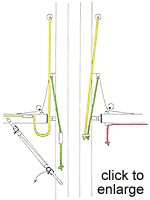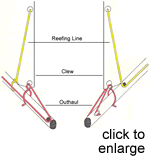The Comet Duo 'Owners Handbook'
 INTRODUCTION:
INTRODUCTION:
This following is intended to introduce You, to Your Duo, and to help
you get
the best from it. There are some hints and tips on sailing the
Duo, but you are
advised to learn the basics at a sailing school or
from a friend who has a dinghy.
Before you sail your Duo for the first
time, the following points should be remembered;
 1) Always wear a Buoyancy Aid/Lifejacket whatever the weather
or your experience.
1) Always wear a Buoyancy Aid/Lifejacket whatever the weather
or your experience.
 2) Choose a sheltered strectch of water, with no strong tides,
currents or big waves.
2) Choose a sheltered strectch of water, with no strong tides,
currents or big waves.
 3) Avoid winds blowing directly off the land onto
water.
3) Avoid winds blowing directly off the land onto
water.
 The real strength of the wind is not discovered until you are
out there in the dinghy.
The real strength of the wind is not discovered until you are
out there in the dinghy.
 4) Depending on your experience, it is a good idea to reef the
mainsail
4) Depending on your experience, it is a good idea to reef the
mainsail
 or even furl the jib as well.
or even furl the jib as well.
TRANSPORTING THE DUO:
TRAILERS:

Most small
trailers are suitable for the Duo, although the Bramber Duo
Combination
Trailer is designed specifically for the Duo. Adjust the trailer
so the
side supports as well as the centre roller take the weight of the
dinghy.
BEFORE YOU START:

Before rigging your Duo for the first time it is best to
study the diagram
and familiarize yourself with the ropes and various
parts of the boat.
KNOW THE ROPES:

| Painter |
 |
Mainsheet Horse |
 |
| Cunningham |
 |
Outhaul |
 |
| Clew Strop |
 |
Reefing Line |
 |
| Mainsheet |
 |
Jib Sheet |
 |
RIGGING THE DUO:

|
 1) Check the halyards are stowed along the mast, and the
top swivel on 1) Check the halyards are stowed along the mast, and the
top swivel on
 the jib furling gear is temporarily attached to
a mast cleat. the jib furling gear is temporarily attached to
a mast cleat.
 2) Make sure the mast gate is open, raise the mast up and
locate the mast 2) Make sure the mast gate is open, raise the mast up and
locate the mast
 foot in its hole and let the mast lean forward.
Close the mast gate. foot in its hole and let the mast lean forward.
Close the mast gate.
|
|
 3) Unwind the shrouds and after checking they are 3) Unwind the shrouds and after checking they are
 not
tangled fasten the two side shrouds keeping not
tangled fasten the two side shrouds keeping
 the rings on
the outside. the rings on
the outside.
 4) Fasten the forestay to the bow shackle using a 4) Fasten the forestay to the bow shackle using a
 triple
purchase & half hitches to tighten the rigging. triple
purchase & half hitches to tighten the rigging.
 5) Fully wind up the jib furling drum anti-clockwise. 5) Fully wind up the jib furling drum anti-clockwise.
 6) Fasten the head of the jib to the top swivel on
the 6) Fasten the head of the jib to the top swivel on
the
 jib halyard and fasten the jib tack to the furling
drum. jib halyard and fasten the jib tack to the furling
drum.
 Clip the top swivel to the forestay. Clip the top swivel to the forestay.
|
|
|
 7) Hoist the jib, hook the loop in the jib halyard onto
the Highfield Lever and 7) Hoist the jib, hook the loop in the jib halyard onto
the Highfield Lever and
 lower the
lever to tighten. Pass the jib sheets inboard of the shrouds
and lower the
lever to tighten. Pass the jib sheets inboard of the shrouds
and
 through the jib sheet fairleads from the outside. Put a
knot in the end of each through the jib sheet fairleads from the outside. Put a
knot in the end of each
 jib sheet.
Fully furl the jib. jib sheet.
Fully furl the jib.
 8) Shackle the tack of the mainsail to the front of the
boom. Tie the clew to 8) Shackle the tack of the mainsail to the front of the
boom. Tie the clew to
 the boom
between the two blocks & thread the outhaul rope as per
diagram. the boom
between the two blocks & thread the outhaul rope as per
diagram.
 9) Tie the reefing line around the middle of the boom
with a bowline and 9) Tie the reefing line around the middle of the boom
with a bowline and
 thread the rope, again as in the diagram. thread the rope, again as in the diagram.
 10) Put on the rudder with the blade fully up. Tie the
mainsheet horse to one 10) Put on the rudder with the blade fully up. Tie the
mainsheet horse to one
 eye on the
transom, pass the other end through the mainsheet swivel
block, eye on the
transom, pass the other end through the mainsheet swivel
block,
 over the tiller, but under the tiller extension and
firmly tie to the other eye. over the tiller, but under the tiller extension and
firmly tie to the other eye.
|
|
 11) Shackle the top mainsheet block to the boom 11) Shackle the top mainsheet block to the boom
 making
sure that the mainsheet is not twisted. making
sure that the mainsheet is not twisted.
 12) Shackle the kicking strap to the mast 12) Shackle the kicking strap to the mast
 and boom, but
have it fully slack. and boom, but
have it fully slack.
 13) Check the boat is head into wind. 13) Check the boat is head into wind.
 Shackle the
mainsail halyard to the top of the sail, Shackle the
mainsail halyard to the top of the sail,
 fee the sail
into the luff groove, pull the sail up fee the sail
into the luff groove, pull the sail up
 and connect
boom to the gooseneck. and connect
boom to the gooseneck.
|
|
 14) Thread the
end of the reefing line through the eye on the mast and tie 14) Thread the
end of the reefing line through the eye on the mast and tie
 a knot
in the end. Thread the cunningham rope through the sail and
fasten a knot
in the end. Thread the cunningham rope through the sail and
fasten
 to the cleat, as in the diagram. Tie the painter to the
bow shackle. to the cleat, as in the diagram. Tie the painter to the
bow shackle. |
LAUNCHING THE DUO:

 1) Make sure the tiller and mainsheet are free to
operate.
1) Make sure the tiller and mainsheet are free to
operate.
 Close the self bailers, and check the drain bung is tight.
Close the self bailers, and check the drain bung is tight.
 2) Check the outhual is not too loose, tighten the kicking
strap a liitle,
2) Check the outhual is not too loose, tighten the kicking
strap a liitle,
 and make sure the reefing line is not too tight.
and make sure the reefing line is not too tight.
 3) Move the boat into the water and hold the bow head to
wind.
3) Move the boat into the water and hold the bow head to
wind.
 4) The helmsman should get in, lower the the rudder and the
centreboard a bit.
4) The helmsman should get in, lower the the rudder and the
centreboard a bit.
 5) Unfurl the jib if needed and the crew should now get
aboard.
5) Unfurl the jib if needed and the crew should now get
aboard.
 6) Sail into deeper water and lower the rudder and
centreboard.
6) Sail into deeper water and lower the rudder and
centreboard.
REEFING:

It is often
sensible to reef the mainsail and even furl the jib in strong winds
if
you are sailing single-handed or are beginners. To reef the mainsail
firstly head
the dinghy into wind, make sure the centreboard is fully
down, and furl the jib.
This helps the dinghy sit head to wind and
makes reefing the mainsail easier.
Loosen the kicking strap, and pull the reefing line on the boom and
cheat.
Uncleat the mainsail halyard and pull down the other end of the
reefing line
until the eyelet is above the boom, and cleat on the
clamcleat on the mast.
Tighten the mainsail halyard. Tidy up the foot of the sail by hooking
the
shockcord under the sail and onto the hook on the other side of the
sail.
Tighten up the kicking strap again, and unfurl the jib if
required.
Whilst a reefed mainsail & jib give easier sailing for lightweights
or in strong winds,
it might sometimes be necessary to sail with just
the reefed mainsail and no jib.
When sailing without the jib, it is
important to remember that when sailing close to
the wind, you should
not pull the boom in as tight as you would if sailing with a jib.
If
you are sailing with a full mainsail and no jib, to stop excessive weather
helm,
you should balance the baot by raising the centreboard a
little.
~ The above information was supplied by AMS
Marine, South Molton, Devon ~







